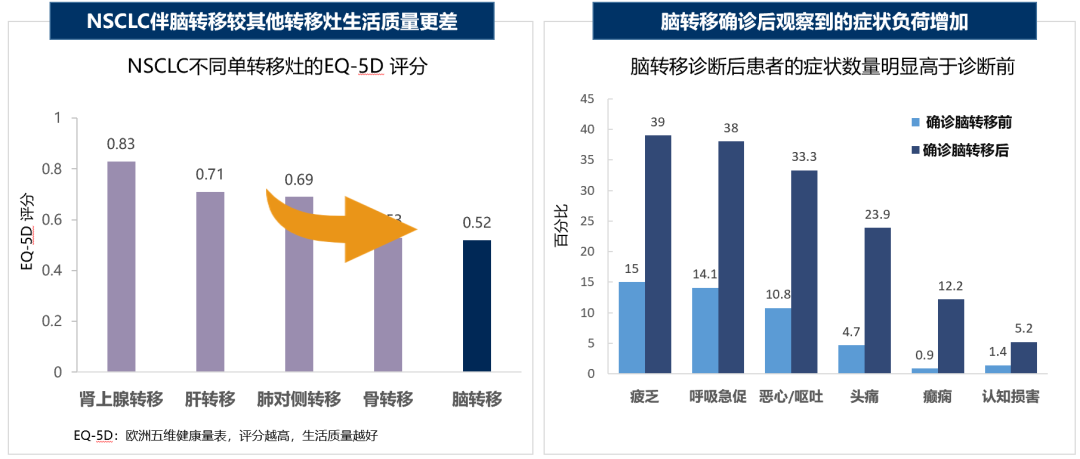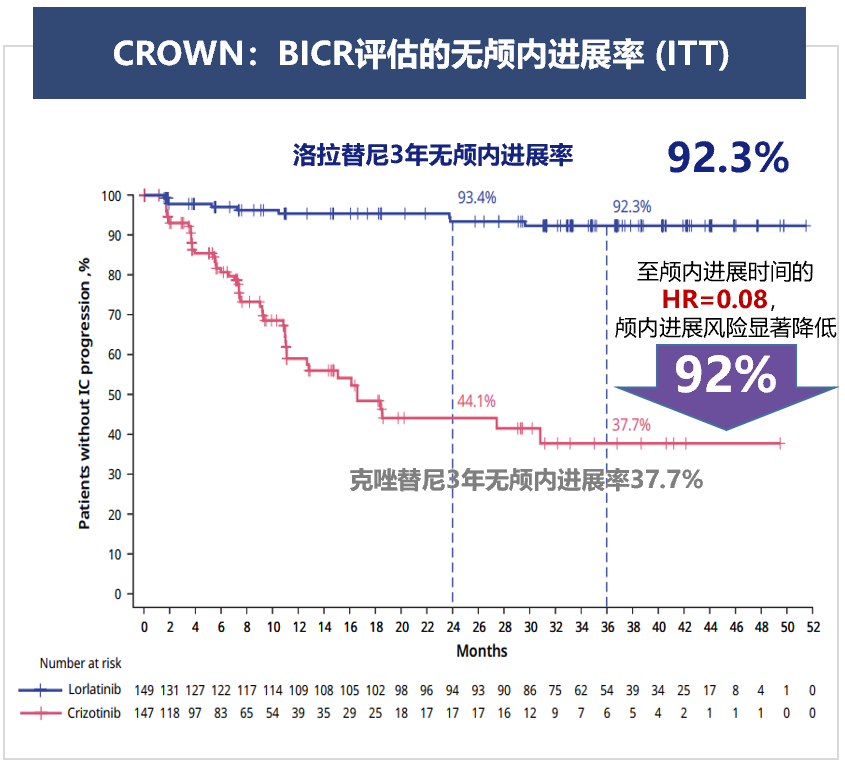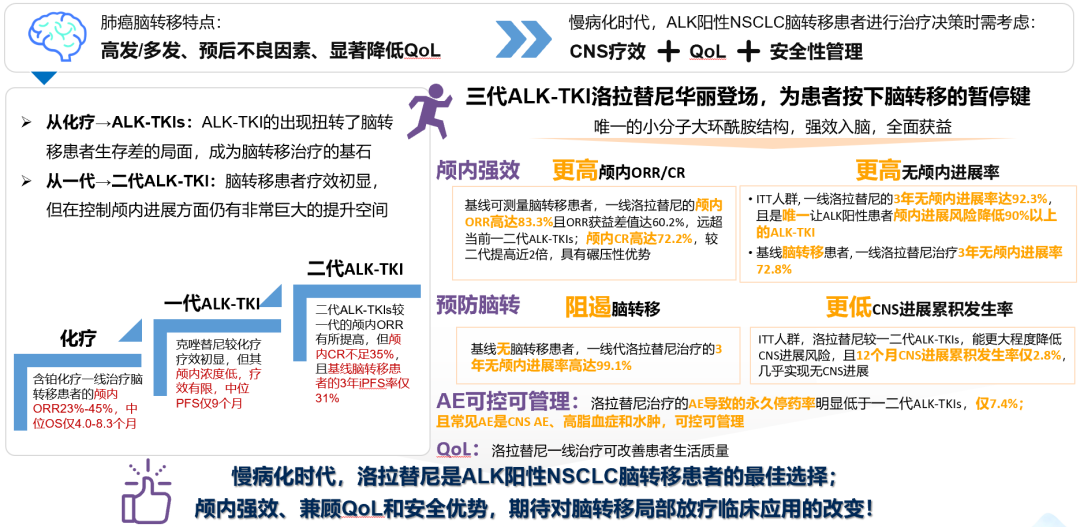Lolatinib shows the effect of strong brain protection, helping NSCLC chronic disease management | full management articles
Author:Cancer Channel of the Medical Time:2022.08.25
*For medical professionals for reading reference

How is Lolatinib's intracranial anti -tumor activity and safety?
Inter -degenerated lymphoma kinase (ALK) fusion gene is another tumor -driven gene that has targeted targeted targeted drug treatment after the adaptering growth factor receptor (EGFR) gene mutation. The overall ALK fusion rate in NSCLC is 3%to 7%. Although the proportion is not high, due to the large population base in my country, the base of ALK -positive NSCLC patients should not be underestimated.
With the listing of first-generation, second-generation, and third-generation ALK-Tyrtinase Inhibitors (TKI), patients' prognosis has been greatly improved. ALK -positive NSCLC has transformed into "chronic diseases", so it is very important to manage the whole process during the long -term diagnosis and treatment of patients. Professor Wu Lin, Hunan Cancer Hospital, combined with Loladinib's intracranial efficacy advantage to interpret the full management of ALK -positive NSCLC patients.
Combined with the intracranial efficacy advantage of Lolatinib, see the full management of ALK -positive patients
With the progress of targeted drugs, ALK -positive NSCLC has entered the era of slow disease management. The central nervous system (CNS) metastasis is an important "block tiger" that affects ALK -positive NSCLC survival. In response to how ALK's positive NSCLC brain metastases treats decisions, Professor Wu Lin from "OLK -positive NSCLC brain metastases" and "ALK -positive NSCLC brain The "metastasis treatment change" and "ALK-TKI therapy ALK-positive NSCLC's safety and quality of life (QOL)" comprehensively explain the full management of ALK-positive NSCLC patients.
ALK -positive NSCLC patients with brain metastases can affect the pre -prognosis, and the treatment is tricky
ALK -positive NSCLC has a high incidence of brain metastases and multiple incidence. About 50%of the number of brain metastases in patients with brain metastases is ≥ 4, and the brain metastases run through the entire course of the patient. The survival of patients with the survival of ALK -positive NSCLC patients is a bad prognosis factor. Compared with patients with other metastases, NSCLC is worse with the QOL patients with brain metastases. The number of symptoms of patients after brain metastases is significantly higher than before the diagnosis. Radiotherapy is the main local treatment method of patients with brain metastases, but it may induce radioactive brain damage. The cumulative incidence of 1 year is 8%-20%, which seriously affects the patient's QOL. In the era of chronic disease, when ALK -positive NSCLC brain metastatic decision -making decisions, not only need to consider intracranial efficacy, but also take into account patient QOL and safety management.

Figure 1. NSCLC with brain metastases to reduce QOL
ALK-TKI iterative listing to solve the treatment problem of NSCLC brain metastases
For chemotherapy drugs, because the molecular weight is large, it is carried and easy to combine with albumin, it is difficult to penetrate the blood transparency brain barrier to play an anti -tumor effect on the intracranial metastatic lesions. A number of studies have shown a limited efficacy of Platinum first-line chemotherapy schemes for the treatment of NSCLC brain metastases. The intracranial objective relief rate (ORR) is 23%-45%, and the median total survival period (OS) is 4.0-8.3 months. The emergence of Alk-TKI has reversed the poor survival of patients with brain metastases. NSCLC's median OS with brain metastases has increased for more than 3 years, changing the treatment strategy of brain metastases, and becoming the cornerstone of the treatment of patients with brain metastases. In recent years, ALK-TKI has progressed rapidly, and various ALK-TKIs have been approved to go public, providing more drug options for patients with CNS metastasis. The efficacy of the first and second-generation ALK-TKI treatment of patients with brain metastases was initially displayed, but there is still room for improvement in controlling intracranial progress.
Subsequently, the three generations of Alk-TKI Lolatinib appeared. With the multiple advantages of the small molecular large-cycleamide structure, it can effectively penetrate the blood-brain barrier. The results of the CROWN study showed that in the crowd of intentional treatment (ITT), the 3 -year intracranial progress rate of the first -line treatment of Lolatinib reached 92.3%.

Figure 2. The 3 -year intracranial progress rate of the first -line treatment of Lolatini reached 92.3%.
For patients with baseline measurement, Lolatinib first -line therapy for intracranial ORR reached 83.3%, and the intracranial relief (CR) rate reached 72.2%. For patients with baseline brain metastases, the three -year intracranial progress rate of Lolatini's first -line treatment is 72.8%. For patients with mening membrane, multiple cases verify that Lolatinib can quickly control the meninge metastases and reduce the disease load. For patients with a brainless metastases of the baseline, the three -year intracranial progress rate of the first -line treatment of the three generations of Lolatinib reached 99.1%, which can effectively prevent brain metastases. The 12 -month CNS progress accumulation rate of Lolatinib to treat the ITT crowd is only 2.8%, which has achieved almost no CNS progress.

Figure 3. Patients with no brain metastases in the baseline, the three -year intracranial progress rate of the first -line treatment of Lolatinib is as high as 99.1%
Take into account the safety and quality of life, Lolatini brings new treatment options for ALK -positive patients
In the management of slow diseaseization of lung cancer, early identification and active intervention of adverse reactions can improve the compliance of patients, avoid unnecessary reduction or stopping drugs, and bring more clinical benefits to patients. There are differences in the safety spectrum of different Alk-TKIs. Among them, Lolatinib treatment is well tolerated, and the permanent drug suspension rate caused by bad events during treatment is only 7.4%. The common adverse events of Lolatinib are hyperlipidemia, edema and CNS adverse events, which can be managed and managed. Among them, hyperlipidemia may not be caused by drugs, and the disease itself can cause abnormal blood lipids. The results of the CROWN research show that Lolatini-related hyperlipidemia is mostly 1-2 and edema is mostly 1-2. The incidence of non-performing incidents in the Chinese population is only 6.4%, which is significantly lower than global data. Based on the unique large -ring structure, Lolatini has a strong blood -brain barrier penetration rate (up to 96%) and strong intracranial efficacy. At the same time, some patients have some adverse reactions. The CROWN research shows that most of the CNS related to Lolatinib is reversible. 90.4%of the CNS AES is a 1 or 2 adverse reaction, and the adverse reactions at level 3 are 9.6%, without the adverse reactions of level 4. Among them, more than half of (60%) patients do not need dose adjustment, and they can heal or maintain adverse reactions at the level 1 (level 1 adverse reaction is the most slightly adverse reaction, basically does not affect life). The remaining patients were cured and effectively improved after dose adjustment or combined medication. Therefore, the CNS AE -related CNS AE -related CNS AE as a whole is controllable and easy to manage. In addition, the dose adjustment caused by bad events due to adverse events has no significant effect on the non -progressive survival period (PFS). In terms of patient report ending, Loladini first -line treatment can improve the QOL of patients.
Figure 4. Summary

Let's talk about clinical practice
In summary, for the treatment of patients with ALK-positive NSCLC, with the development and application of the new generation of Alk-TKI, many new weapons have been clinically added. It is very important to improve the prognosis of patients. Professor Zhou Jianying, the First Affiliated Hospital of Zhejiang University Medical College, Professor Li Champions of the Shanghai Mental Health Center, Professor Li Yong of Huashan Hospital Affiliated to Fudan University, and Professor Yang Zhenzhou, Affiliated to Chongqing Medical University. Drugs and full -process management, and experience of multi -disciplinary diagnosis and treatment sharing viewpoints.
Professor Zhou Jianying: Multi -disciplinary diagnosis and treatment model (MDT) composed of a working group by multi -department experts such as surgery, oncology, radiotherapy, video department, pathology department, etc. to jointly formulate the best treatment plan, which can make NSCLC brain metastases the most benefits to the greatest benefit change. In response to NSCLC brain metastases, the three generations of Alk-TKI Lolatinib appeared, which can significantly reduce the risk of intracranial progress and effectively prevent the occurrence of brain metastases. Therefore, it is hoped that Lolatini can enter the national medical insurance as soon as possible to benefit more Chinese patients.
Professor Li Chao: During the treatment of Lolatinib, doctors can initially evaluate the patient's adverse reactions through the 90 seconds 4 interrogation method, multiple meters and other means. After the symptomatic treatment of the corresponding department, adverse events can usually be relieved. For example, when there are adverse reactions such as depression and excitement, you can seek the help of psychiatry and psychologists.
Professor Li Yong: As the target of diamond mutation, ALK is developed and listed on the market, and the patient's OS continues to break through. Three generations of Alk-TKI Lolatini's Crown research created an ultra-long PFS of Alk's positive NSCLC. OS results are worth looking forward to. With the extension of the patient's survival, the incidence of cardiovascular diseases gradually increases. During the treatment of ALK-TKI, the oncologist needs to pay attention to the occurrence of cardiovascular disease, and can cooperate with cardiac doctors to achieve positive prevention and symptomatic management of cardiovascular disease and improve the QOL of patients.
Professor Yang Zhenzhou: For patients with the baseline measurement of brain metastases, Lolatinib first -line treatment of intracranial lesions can consider using radiotherapy after reaching CR. If the intracranial lesion reaches partial relief or stable condition, the oncologist can consider cooperating with the radiotherapist doctor. Radiation therapy is implemented, but the timing and method of radiotherapy need further inquiry and exploration. At the same time, it is also expected that more new anti -tumor drugs such as Lolatinib can be included in the national medical insurance catalog, providing better and more available treatment options for domestic ALK -positive advanced lung cancer patients.
*This article is only used to provide scientific information to medical people, and does not represent the viewpoint of this platform


- END -
The Pearl River Basin has a large romance

Xinhua News Agency, Beijing, June 14th. On the 14th, the Ministry of Water Resourc...
The average daily flow of 30,000 people!The new "night" state of Qingyun City, Guyang Yun, releases new vitality

Speaking of Qingyun Road, the first impression of the citizens is the late night c...